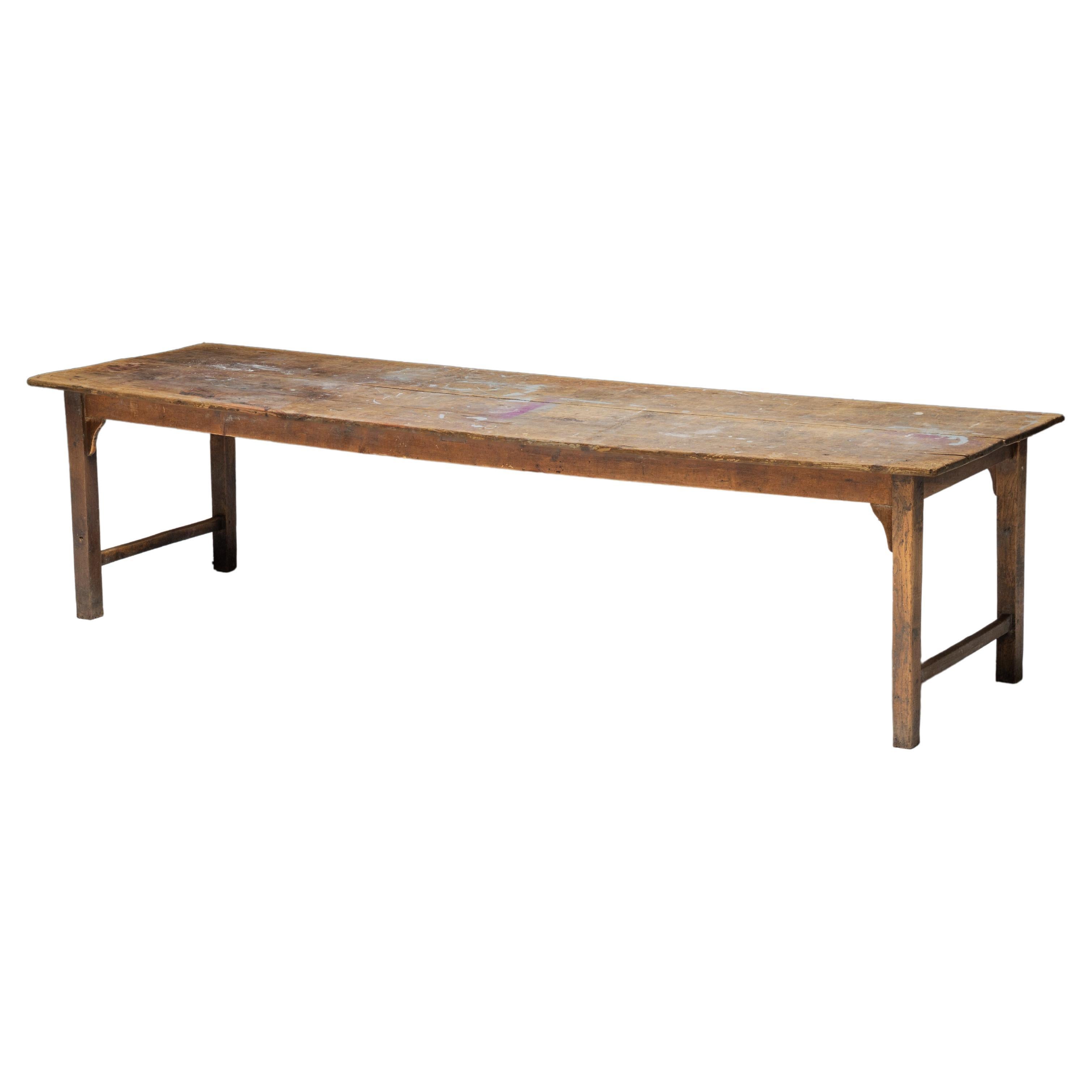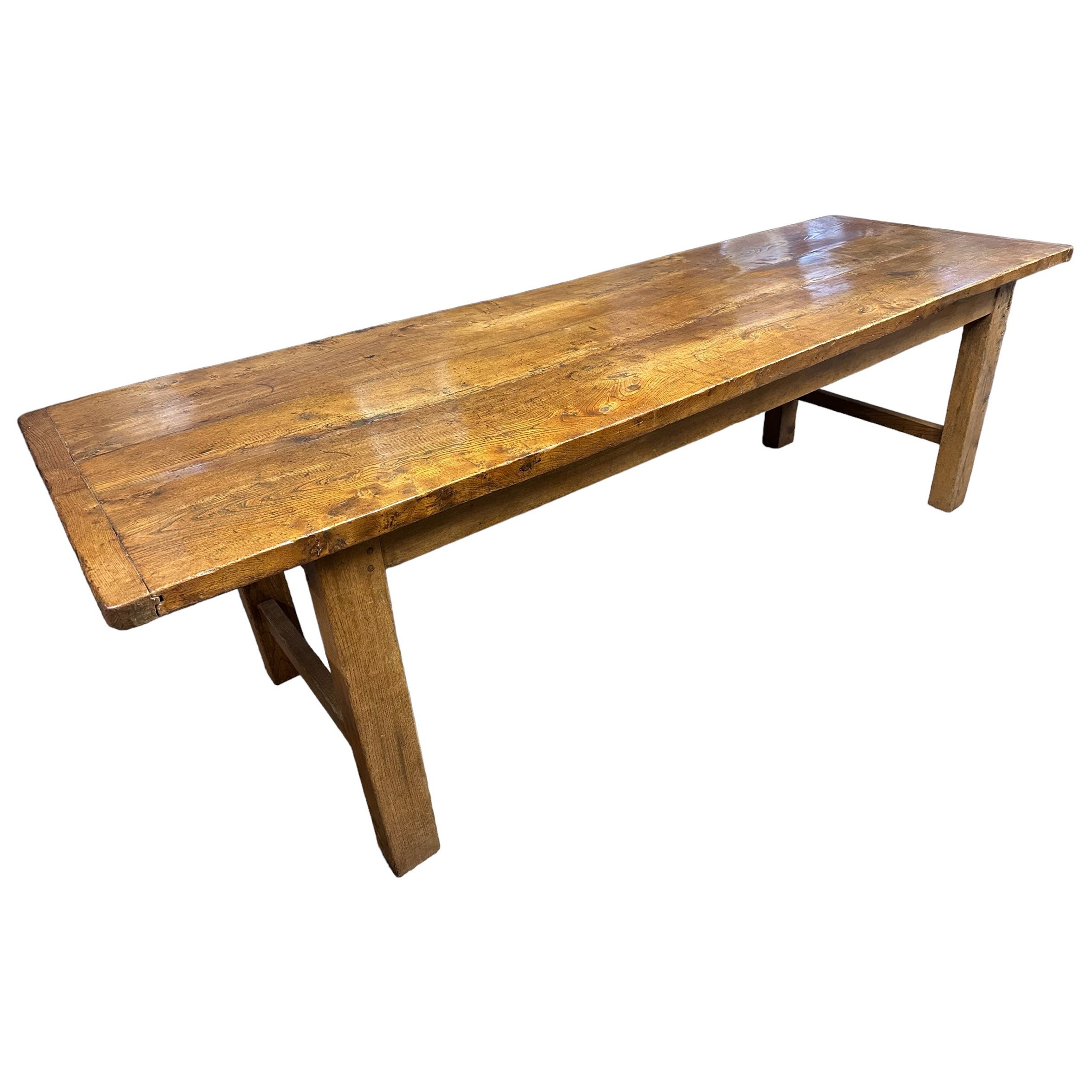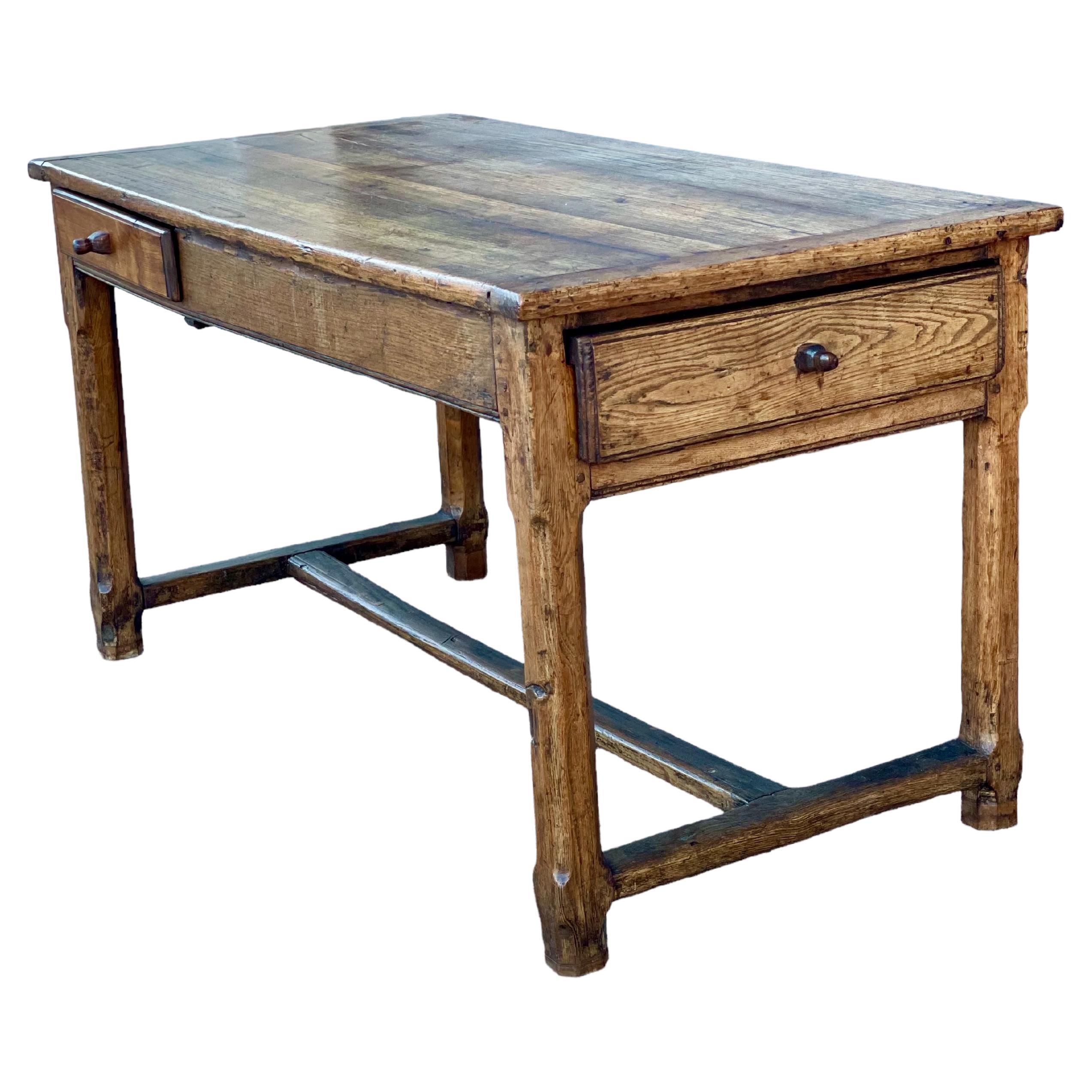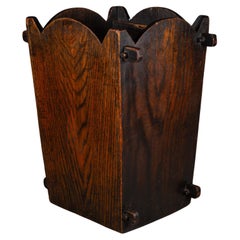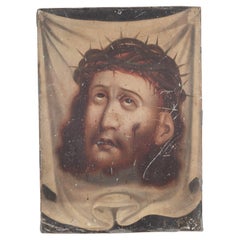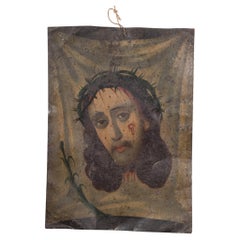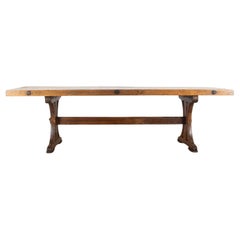
Mid 19th c. Primitive Mexican Mennonite Farmhouse Table c.1850
View Similar Items
Want more images or videos?
Request additional images or videos from the seller
1 of 10
Mid 19th c. Primitive Mexican Mennonite Farmhouse Table c.1850
About the Item
- Dimensions:Height: 31.5 in (80.01 cm)Width: 60 in (152.4 cm)Depth: 30.25 in (76.84 cm)
- Style:Rustic (Of the Period)
- Materials and Techniques:
- Place of Origin:
- Period:
- Date of Manufacture:1850
- Condition:Wear consistent with age and use.
- Seller Location:San Francisco, CA
- Reference Number:Seller: SKU 0401stDibs: LU1280239035002
About the Seller
5.0
Platinum Seller
These expertly vetted sellers are 1stDibs' most experienced sellers and are rated highest by our customers.
Established in 2014
1stDibs seller since 2015
1,202 sales on 1stDibs
Authenticity Guarantee
In the unlikely event there’s an issue with an item’s authenticity, contact us within 1 year for a full refund. DetailsMoney-Back Guarantee
If your item is not as described, is damaged in transit, or does not arrive, contact us within 7 days for a full refund. Details24-Hour Cancellation
You have a 24-hour grace period in which to reconsider your purchase, with no questions asked.Vetted Professional Sellers
Our world-class sellers must adhere to strict standards for service and quality, maintaining the integrity of our listings.Price-Match Guarantee
If you find that a seller listed the same item for a lower price elsewhere, we’ll match it.Trusted Global Delivery
Our best-in-class carrier network provides specialized shipping options worldwide, including custom delivery.More From This Seller
View All19th c. Primitive Oak Umbrella Stand or Waste Paper Basket c.1800s
Located in San Francisco, CA
ABOUT
A primitive Oak umbrella stand or waste paper basket with mortise and tenon construction.
CREATOR Unknown.
DATE OF MANUFACTURE c.1800s.
MATERIALS AND TECHNIQUE...
Category
Antique 19th Century Rustic Umbrella Stands
Materials
Oak
19th C. Mexican Retablo Saint Francis c.1880
Located in San Francisco, CA
About
An original 19th century Mexican folk retablo of Saint Francis. Oil paint on tin.
St. Francis of Assisi, Italian San Francesco d’Assisi was born 1181-1182 in Assisi, duchy of...
Category
Antique 19th Century Mexican Folk Art Paintings
Materials
Tin
19th C. Mexican Retablo "Veronica's Veil", c.1880
Located in San Francisco, CA
About
An original 19th century Mexican folk retablo "Veronica's Veil" or "El Divono Rostro" in Spain . Oil paint on tin.
The Veil of Veronica, known in Italian as the Volto Santo or Holy Face, is a Roman Catholic Relic which, according to legend, bears the likeness of the Face of Jesus that was imprinted on it prior to Jesus' crucifixion. According to Roman Catholicism, Saint Veronica encountered Jesus in Jeruselum on the way to Calvary. When she paused to wipe the sweat (Latin, suda) off his face with her veil, his image was left on the veil.
In the small village of Osa de la Vega in Spain, there lived a couple who led a very pious life. They were Gregorio de la Torre and Isabel Corral. From their father, Juan Montilla, they inherited a picture of the Face of Jesus or the Divino Rostro. A story that is told one day, to the amazement of many who confirmed its veracity, the picture began to perspire with living blood. News of this extraordinary event spread swiftly and widely throughout the land.
CREATOR Unknown.
DATE OF MANUFACTURE c.1880.
MATERIALS AND TECHNIQUES Oil Paint on Tin.
CONDITION Good. Wear consistent with age and use.
DIMENSIONS H 14 in. W 10 in.
HISTORY
Retablos, better known as 'laminas' in Mexico, are small oil paintings on tin, wood and sometimes copper which were used in home altars to venerate the almost infinite number of Catholic saints. The literal translation for 'retablo' is 'behind the altar.' This unique genre of art, deeply rooted in European history, was brought to Mexico with the arrival of the Spanish and then ultimately adopted by New World mestizo natives to become what is known today as the Mexican folk retablo.
The retablo was an art form that flourished in post conquest Mexico and then ultimately, with the introduction of inexpensive mediums such as tin, reached its pinnacle of popularity in the last quarter of the 19th century. With some exceptions, mostly untrained artists from the provinces worked to produce and reproduce these sacred images; some subjects painted more prolifically than others. A typical "retablero" may have reproduced the same image hundreds, if not thousands of times in his or her career.
These oil paintings were sold to devout believers who displayed them in home altars to honor their patron saints. There are virtually hundreds of saints, each invoked to remedy a different situation. "San Ysidro Labrador," the patron saint of farmers, is venerated for good weather...
Category
Antique 19th Century Mexican Folk Art Paintings
Materials
Tin
19th c. Mexican Retablo "Veronica's Veil" c.1880
Located in San Francisco, CA
ABOUT
An original 19th century Mexican folk retablo "Veronica's Veil" or "El Divono Rostro" in Spain . Oil paint on tin.
The Veil of Veronica, known in Italian as the Volto Santo or Holy Face, is a Roman Catholic Relic which, according to legend, bears the likeness of the Face of Jesus that was imprinted on it prior to Jesus' crucifixion. According to Roman Catholicism, Saint Veronica encountered Jesus in Jeruselum on the way to Calvary. When she paused to wipe the sweat (Latin, suda) off his face with her veil, his image was left on the veil.
In the small village of Osa de la Vega in Spain, there lived a couple who led a very pious life. They were Gregorio de la Torre and Isabel Corral. From their father, Juan Montilla, they inherited a picture of the Face of Jesus or the Divino Rostro. A story that is told one day, to the amazement of many who confirmed its veracity, the picture began to perspire with living blood. News of this extraordinary event spread swiftly and widely throughout the land.
CREATOR Unknown.
DATE OF MANUFACTURE c.1880.
MATERIALS AND TECHNIQUES Oil Paint on Tin.
CONDITION Good. Wear consistent with age and use.
DIMENSIONS H 14 in. W 10 in.
HISTORY
Retablos, better known as 'laminas' in Mexico, are small oil paintings on tin, wood and sometimes copper which were used in home altars to venerate the almost infinite number of Catholic saints. The literal translation for 'retablo' is 'behind the altar.' This unique genre of art, deeply rooted in European history, was brought to Mexico with the arrival of the Spanish and then ultimately adopted by New World mestizo natives to become what is known today as the Mexican folk retablo.
The retablo was an art form that flourished in post conquest Mexico and then ultimately, with the introduction of inexpensive mediums such as tin, reached its pinnacle of popularity in the last quarter of the 19th century. With some exceptions, mostly untrained artists from the provinces worked to produce and reproduce these sacred images; some subjects painted more prolifically than others. A typical "retablero" may have reproduced the same image hundreds, if not thousands of times in his or her career.
These oil paintings were sold to devout believers who displayed them in home altars to honor their patron saints. There are virtually hundreds of saints, each invoked to remedy a different situation. "San Ysidro Labrador," the patron saint of farmers, is venerated for good weather...
Category
Antique 19th Century Mexican Folk Art Paintings
Materials
Tin
Large Reclaimed Australian Hardwood Dining Table
Located in San Francisco, CA
ABOUT
This large custom reclaimed hardwood dining table from Melbourne, Australia is perfect for hosting large gatherings. The classic rustic design is made from a reclaimed cricket...
Category
21st Century and Contemporary Australian Rustic Dining Room Tables
Materials
Hardwood
$5,495 Sale Price
51% Off
Large Early 19th c. Polychromed Mexican Carved Wooden Santo c.1820
Located in San Francisco, CA
ABOUT
A large early 19th century poly-chromed, hand carved wooden Mexican Santo holding a book. A lustrous finish envelops his face, arms, legs and feet, causing his flesh to gleam in the light while blue paints cover the areas where he was possibly clothed at one time. Glass eyes and thick, carved hair. Carved wooden stand with support bar attached in the back. The articulating arms are hinged and bend at the shoulder and elbow for many different positions.
Shown with life size hand model.
CREATOR Unknown. Mexico.
DATE OF MANUFACTURE c.1820.
MATERIALS AND TECHNIQUES Carved, Painted Wood.
CONDITION Good. Wear consistent with age and use. Missing piece above book. Chip under left eye. Chipping paint throughout. Repair to left foot. Structurally sound.
DIMENSIONS H 36 in. W 10.5 in. D 10 in.
HISTORY
Santos played an important role in bringing the Catholic Church to the New World with the Spanish colonists. These religious figures were hand-carved and often furnished with crowns, jewels, and other accessories, usually funded by religious devotees, and were used as icons to explain the major figures - Mary...
Category
Antique 19th Century Mexican Spanish Colonial Figurative Sculptures
Materials
Wood, Paint
$2,895 Sale Price
63% Off
You May Also Like
Rustic Primitive Farmhouse Dining Table, France, 19th Century
Located in Antwerp, BE
19th-century French farmhouse dining table with a naturally aged patina, embodying the timeless beauty of the French countryside. The table’s surface, adorned with colourful paint sp...
Category
Antique 19th Century French Rustic Dining Room Tables
Materials
Wood
19th Century Farmhouse Table
Located in Gloucestershire, GB
Stunning example of an early 19th Century French farmhouse table.
Circa 1820 and came direct from a farm in the region of Provenance.
The two-planked top has so much character in t...
Category
Antique Early 19th Century Dining Room Tables
Materials
Elm
Primitive 19Th C. Catalan Dinning Table
Located in London, GB
A good sized 19th Catalan dinning table with traditional “A” frame legs.
Heavily patinated through years of use with many age old repairs.
Sympathetically restored in our London wo...
Category
Antique 19th Century Spanish Dining Room Tables
Materials
Wood
19th Century Country American Pine Farmhouse Work Table
Located in Rio Vista, CA
Rustic early 19th century country American farmhouse work table. Features a 1 inch thick pine plank top. Constructed with hand-made nails...
Category
Antique 19th Century American Rustic Dining Room Tables
Materials
Pine
Large Rustic Primitive Dining Table, France, 19th Century
Located in Antwerp, BE
19th-century impressive French antique dining table, a captivating piece of rural heritage, perfect for large gatherings. Crafted with a beautifu...
Category
Antique 19th Century French Rustic Dining Room Tables
Materials
Wood
Primitive Wabi Sabi Dining Table, France, 19th Century
Located in Antwerp, BE
Originally from 19th-century France, this farmhouse table embodies rustic charm with its endearing natural patina, which has developed over years of use. The table is constructed fro...
Category
Antique 19th Century French Rustic Dining Room Tables
Materials
Wood
